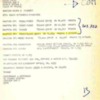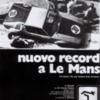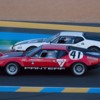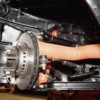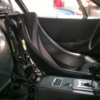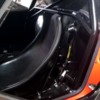This last Telex gives the final price list for the cars ordered by AHI. Note that 8263 is again listed as Pantera GT4. What's more, its price is only 35.500 DM while the regular GT5 (like 9170, 9171 or 9174 on the list) are all between 58.000 DM and 61.000 DM.
Another evidence that 8263 was built on a used car, the old factory Group 4 2263.
I appreciate the well presented, and interesting description of your car, and it’s provance.
Thank you for presenting this history in a reasonable and clear manner. You've got some great historical pictures, too!
Rocky
Thank you for presenting this history in a reasonable and clear manner. You've got some great historical pictures, too!
Rocky
...those Schwaged holes are beyond what anybody but the factory would do (at least, since each hole requires access on both sides to locate the die used to create the flare, the idea that anybody but the factory made the holes and then cover them over with carpets, is really past belief. Only really believable that the raw panels were schwaged and then welded into a car.
With such minor accident damage to 263 at Monza, interesting that the racing stopped right there...Lee
With such minor accident damage to 263 at Monza, interesting that the racing stopped right there...Lee
Rik911 made the same demonstration as eb911 on the Autodiva french forum (Pantera thread http://www.autodiva.fr/forum/v...=2&t=1183&start=1320 ) olczyk was on the forum also, and he was injurious to all people who said that the demonstration was really clear ! The thread is now locked ! But my opinion is that Rik911 made a faboulous job and it is now clear that 8263 was build with 2263 bodyshell;
Somebody here said that main problem was insurance... i am agree with that...
Somebody here said that main problem was insurance... i am agree with that...
I have to agree, it is nice to see a structured argument and presentation of data and a very interesting piece of history.
Although I concede that 8263 is likely 2263 based on the anecdotal evidence, I don't think the car can be categorically presented as 2263, it is still '8263 with an interesting history suggestive that it was built out of 2263'.
Although I concede that 8263 is likely 2263 based on the anecdotal evidence, I don't think the car can be categorically presented as 2263, it is still '8263 with an interesting history suggestive that it was built out of 2263'.
The car can be know today as 8263/2263 or 2263/8263 in the same manner than for Porsche 917 014/034 or so many other example...
We feel we have brought enough evidences that 8263 is the genuine De Tomaso Pantera Group 4 chassis 2263, the very first group 4 built by the factory. We hope that now, anyone can make his own opinion on our car.
Again, we have never denied that 2263 had been used to build a GT5 demonstrator and that a new chassis number 8263 had been stamped by the factory in 1979. That chassis number 8263 is still on the car today because it is part of its history. But it does not erase its previous history as 2263 with Herbert Muller. Our car is made of the original chassis of 2263, and for that simple reason it is 2263.
The following notion is rather largely accepted today : the identity of a car is defined by its original chassis on which is attached a chassis number. If the original chassis has not been destroyed, the chassis number is attached to the chassis, and there is no reason to split them. If the chassis is destroyed at some point, the chassis number can be transferred to a new chassis under certain conditions.
In the case of 2263, the original chassis still remains today so that the original identity is still attached to it. Of course, the factory has stamped that chassis with another number for some reasons, but it does not in any case erase the identity and the history attached to the original chassis.
The closest example is Pantera Group 4 chassis 2824. It was delivered new with a plate stamped with chassis number 2342 by the factory. Problem, there was another Group 4 chassis 2342 delivered by the factory. It is only in 1996 that the real identity of 2824 had been discovered by its then owner, under the stamped plate. The car is today recognized as 2824, its original identity, despite the factory sold it officially with number 2342 in 1972. Why would it be otherwise ? Saying that 2824 should be 2342 for ever, and that its original identity 2824 is dead, is a nonsense.
We would like to conclude that we are genuine enthusiasts, and have always been in love with the wide body Pantera Group 4. We found this car, rediscovered the history with the previous owner, restored it back to its original 1972 specs for 18 months, so as to be able to be back on the track where it has always belonged. This was a dream come true to be able to race it at Le Mans Classic the same place where Herbert Muller broke the lap record and top speed for a GT car 46 years ago.
Again, we have never denied that 2263 had been used to build a GT5 demonstrator and that a new chassis number 8263 had been stamped by the factory in 1979. That chassis number 8263 is still on the car today because it is part of its history. But it does not erase its previous history as 2263 with Herbert Muller. Our car is made of the original chassis of 2263, and for that simple reason it is 2263.
The following notion is rather largely accepted today : the identity of a car is defined by its original chassis on which is attached a chassis number. If the original chassis has not been destroyed, the chassis number is attached to the chassis, and there is no reason to split them. If the chassis is destroyed at some point, the chassis number can be transferred to a new chassis under certain conditions.
In the case of 2263, the original chassis still remains today so that the original identity is still attached to it. Of course, the factory has stamped that chassis with another number for some reasons, but it does not in any case erase the identity and the history attached to the original chassis.
The closest example is Pantera Group 4 chassis 2824. It was delivered new with a plate stamped with chassis number 2342 by the factory. Problem, there was another Group 4 chassis 2342 delivered by the factory. It is only in 1996 that the real identity of 2824 had been discovered by its then owner, under the stamped plate. The car is today recognized as 2824, its original identity, despite the factory sold it officially with number 2342 in 1972. Why would it be otherwise ? Saying that 2824 should be 2342 for ever, and that its original identity 2824 is dead, is a nonsense.
We would like to conclude that we are genuine enthusiasts, and have always been in love with the wide body Pantera Group 4. We found this car, rediscovered the history with the previous owner, restored it back to its original 1972 specs for 18 months, so as to be able to be back on the track where it has always belonged. This was a dream come true to be able to race it at Le Mans Classic the same place where Herbert Muller broke the lap record and top speed for a GT car 46 years ago.
Attachments
is there, or are there plans to publish a book that documents the restoration and the details of the G4 car
I saw the car at Le Mans this summer on Friday night in the paddock. It looks absolutely beautifull! Right down to the original Gr4 racing seat. It really was like travelling back in time. You said you wanted to get the details right, well you took that to a whole new level.
P.s I also loved the black&white photo you had of Herbie Muller leaning casually against the car.
P.s I also loved the black&white photo you had of Herbie Muller leaning casually against the car.
The Reaper (Guest)
quote:Originally posted by Rik911:
You will see the end result of course. And you are right the original Pantera Group 4 parts are very hard to find.
You have proven the chassis was originally 2263. Then you jumped to the end of the process showing pictures of the car on the track. You've skipped several steps. You haven't shown pictures of the other parts that went into building your car. A group 4 chassis without a group 4 engine, group 4 suspension, group 4 brakes, group 4 interior, group 4 roll cage, etc is not a group 4. It is not 2263 until it authentically equipped to its original spec.
When do we get to see pictures detailing the other parts that prove this car has been authentically restored to its original spec?
i guess that the air in tires is not original 
quote:Originally posted by MUSTANG66:
i guess that the air in tires is not original
maybe not from 1972 but they went to the Loire region to fill the tires, that would suffice no!
( the standard joke for deTomaso guys is: 'Does the Air Conditioning still work', and the answer is 'it may need a recharge' but I doubt this car has AC)
Welcome to out forum
yes interested in pictures, I'm trying to build a gr4 replica too 
quote:
When do we get to see pictures detailing the other parts that prove this car has been authentically restored to its original spec?
We aimed at posting the history of the car here on which we focused, but here are some detailed pictures for you.
Group 4 engine built by Guy Trigaux. 532 HP @6900 Rpm - 422 Ft.Lbs @5000 rpm (572 Nm).
Attachments
I thought the Group 4 cars had an adjustable front sway bar?
I remember also the front A-arms location are different on this Gr4.
drilled holes on a different place.
Simon
drilled holes on a different place.
Simon
quote:Originally posted by Joules:
I thought the Group 4 cars had an adjustable front sway bar?
Correct. There has been a discussion within our team to know if the very first Group 4 did have the adjustable sway bars or not. That might be a later upgrade.
Very nice !
I sent you a PM ... Porsche fan too ...
Philippe
I sent you a PM ... Porsche fan too ...
Philippe
Along with the stamped (not drilled) frame and cabin perforations, another way to differentiate a street Pantera from the GR-4/GT-4 racers is, there were no mounting holes nor brackets provided for a heater/AC box under the dash, nor for the e-brake assembly to the console or its lever's slot in the floor pan.
The Reaper (Guest)
Rik911 thank you for posting the additional pictures. You and your team have done well. 
I have two follow-up questions. The first is in regards to the engine, is it equipped with a dry sump lubrication system? The second is in regards to the two uprights in the picture below, yellow arrows pointing at them. Are they attached at the upper ends to the roll bar in the interior, as per the original?
I have two follow-up questions. The first is in regards to the engine, is it equipped with a dry sump lubrication system? The second is in regards to the two uprights in the picture below, yellow arrows pointing at them. Are they attached at the upper ends to the roll bar in the interior, as per the original?
Attachments
quote:Originally posted by The Reaper:
The first is in regards to the engine, is it equipped with a dry sump lubrication system?
Yes dry sump
quote:Originally posted by The Reaper:
re they attached at the upper ends to the roll bar in the interior, as per the original?
Yes, see picture here under
Attachments
Add Reply
Sign In To Reply


